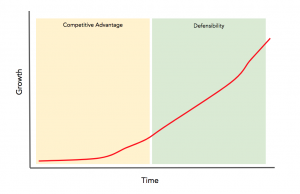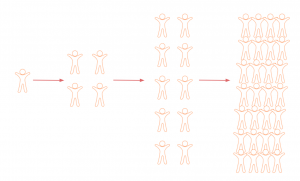In this edition of the GrowthSwipeFile, we ask is it possible to add defensibility into your marketing efforts?
Successful businesses have some competitive advantages that help the company to become successful. But the truly successful businesses have some form of defensibility, which helps them maintain that success.
We get into the differences between competitive advantages and defensibility. We cover the most common types of defensibility that successful businesses have. And, we then ask, how do competitive advantages and defensibility work in marketing?
When it comes to growing businesses, competitive advantages help you to become successful. However, a lot of those advantages diminish as more competition enters the market. What helps businesses to maintain that success is adding defensibility.

What do we mean by competitive advantages?
Some growing companies have competitive advantages in their market, which helps them get a bunch of early growth. Below are some of the more common examples:
1. Investment: Some companies manage to raise more funds for competitors. That allows them to hire more rapidly, spend more on marketing and sales. However, it's not always an advantage if not used correctly. Just ask the businesses that Softbank's Vision fund invested in, the fund lost 18 billion last year. Yes, that's BILLION !!
2. Talent: The company could have some unique skillsets in their team, which provide an initial advantage over competitors. Either they're more technically gifted, or understand the market better than others.
3. Relationships: Some founders may have existing relationships that give them an initial advantage in the market. Look at the rapid rise of the social app Clubhouse. It's still in private beta but is already valued at $100 million. A lot of their early growth came from the founder's networks, including the VCs who had invested in it.
4. Location: Where you located your business has traditionally been a competitive advantage, e.g., tech in San Fran, finance in New York. Hopefully, the rise in remote work will change this.
Most of these competitive advantages diminish over time. For example, if you're an early mover in a market, and have some initial success, that success will help to validate the market. Other competitors will enter, raise sizeable rounds of investment, hire talent, set up in the same location, and utilize relationships.
Free markets are efficient. Success breeds competition
Adding defensibility helps the business to maintain that success.
The four most common types of defensibility are:
1. Scale: When a company becomes dominant within its market, it allows them to do things that will make it difficult for competitors to upend them.
In the US, the food delivery market is dominated by a small number of companies. Two of these are UberEats (with 22% of market share) and Grubhub (with 23% of market share). There has been a lot of talk about Uber wanting to buy Grubhub to increase its market dominance. That kind of scale means Uber can use their size to bargain for better rates with restaurants, offer cheaper food to customers and make the margins so razor-thin that it's hard for any other business to compete.
Of course, Amazon is another example of a company that benefits from economies of scale, by having the most inventory, best prices, and fastest delivery times.
2. Brand: Some companies reach the promised land of becoming synonymous with the thing they do, often by creating a new product category, or doing something vastly better than competitors.
You don't search for something; you Google it, you don't message someone, you Slack them, you don't do a video hangout, you Zoom them.
3. Embedded/Switching Costs: Some companies have products so profoundly embedded with how a company does work; it's challenging to switch to a competitor. Software categories like HR, Fintech, CRM, CMS have products that benefit from this. You'll often see categories like this have products with very low NPS and very high retention rates.
4. Network Effects: The most common defensibility type is adding network effects to your product. A network effect is when one user joining the product or service makes that product or service better for all other users.
The most common examples are:
a. Direct Network Effects: Social networks like Facebook, LinkedIn, and messaging apps like Whatsapp, Facebook Messenger.
b. Two-Sided Network Effects: Marketplaces like Airbnb, Craigslist, eBay, where increasing volume to one side of the marketplace improve the experience for the other.
c. Data Network Effects: Platforms like Yelp, Tripadvisor, where the product usage (adding reviews) enhances the experience for all users.
There are many other types of network effects, for a comprehensive round-up of these, here is an excellent article.
What about competitive advantages and defensibility in marketing?
The competitive advantages you have as a marketing team, are near identical to those you have as a business.
1. Capital: If I have more capital than competitors, I can hire better people for things like content marketing, SEO, paid. I can spend more on paid advertising and brand campaigns. As per Softbank's Vision fund, being able to outspend competitors on marketing, and getting a real advantage still comes down to execution.
2. Talent: There are ways to attract better talent than competitors outside of having more money. Two big factors in this are:
- Solving an interesting problem with a broad market. Great people are attracted to big opportunities. You just need to sell them on it.
- The internal network of the existing team. Great people know and attract great people.
3. Paid Unit Economics: There are ways to outspend competitors by monetizing the demand you get from paid more effectively than competitors.
- If you're a multi-product company, your customer LTV may be higher than competitors who are a single product. You're able to cross-sell customers onto other products.
- If you're able to charge more for your products, you'll again have a better customer LTV, and can reinvest more into paid advertising.
4. Relationships: See above for Clubhouse. Existing relationships can help your brand initially grow quicker than competitors.
5. Buzz: Some brands benefit from having a lot of initial buzz. Robinhood, the financial app, had X users signed up for their beta before ever launching.
Most competitive advantages that help you out-market competitors vanish overtime. So, what can help you to maintain that success? Can you add defensibility to your marketing?
>> It's HARD to make your marketing defensible. That's the TLDR :/ <<
Let's give some examples for us to think about ...
1. Adding defensibility to content marketing
Having the first-mover advantage means you're able to create a publishing model for your market and establish yourself as a thought leader in that space. It helps your content to become the go-to source on that subject and makes it very difficult for competitors to displace you.
Another version of this is category creation. If you've established a new category for your product/service, it helps to cement your content as the go-to resource in that market.
Lastly, if you have unique data sources to create content around, it's difficult for other companies to replicate it. Having more data is somewhat a byproduct of scale. For example, if using data from customers in your content, having more customers than anyone else means your data-set will be better. At HubSpot, we recently launched a benchmark tool based on data from our customers.
2. Adding defensibility via domain authority
Another potential first-mover advantage is building a better domain authority than competitors, making your content more successful in Google.
Competitors can aim to replicate this by creating quality content and generating links to their domain. But, in recent years, websites link out a lot less, making it a lot harder for new businesses to grow their domain authority.
3. Add defensibility via Virality
Virality is somewhere in between competitive advantage and potential defensibility strategy for marketing.
If you have a product with a k-factor > 1, you have a viral product and one user signing up for your product, results in many more users signing up because of their usage.

Having a viral product is, without a doubt, a competitive advantage that can help you to grow. It can add defensibility to your marketing if you're able to optimize it, continue to grow user signups from it, and be able to monetize those signups.
For example, in our episode with Tope Awotona, the CEO/Co-Founder of Calendly, he talked about how Calendly added customer support for their free users. Not many businesses could afford to provide customer support for free users. Because Calendly's product is viral (k-factor > 1), they can count that customer support cost as a customer acquisition cost. They know by getting new free users onboarded to Calendly, those users will, in turn, result in other free users joining the product.
Doing this episode was a fun thought exercise in trying to think about what could make your marketing defensible. It turns out; it's hard to come up with a list of what you could add to your marketing strategy that can't be replicated by competitors. The majority of the competitive advantages and defensibility strategies marketing has are whatever ones the business as a whole has.
If you can think of ones we haven't covered, please do tweet me at @searchbrat, and I'll be sure to include them in this post.
 iTunes
iTunes Stitcher
Stitcher Spotify
Spotify